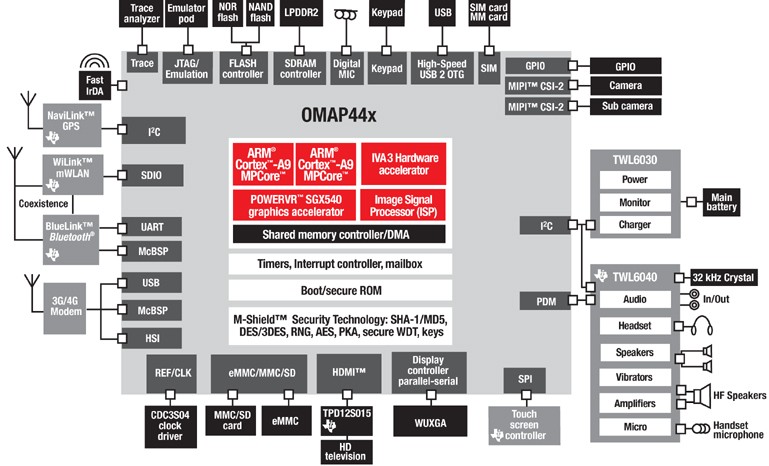Texas Instruments recently announced its next-generation application processor family, OMAP 4. The OMAP 4 chip family targets smart phones and mobile internet devices (MIDs) and incorporates a number of distinct processing engines. General-purpose processing is provided via a dual-core SMP processor based on two ARM Cortex-A9 cores, both of which include the NEON multimedia extensions. As shown in Figure 1, OMAP 4 chips also include an imaging engine (TI’s ISP), graphics engine (Imagination Technologies’ POWERVR SGX540), programmable video engine (TI’s IVA3) and “audio backend engine” (TI’s ABE).

Figure 1: Block diagram of OMAP44x. Figure courtesy of TI.
The new chips will be fabbed in the low-leakage “dot M” 45 nm process that TI has been using in custom baseband devices since 2007. OMAP 4 chips are expected to start sampling in the second half of 2009 with full production a year later. Like some previous OMAP chips, OMAP 4 chips will initially be available only to high-volume OEMs and ODMs; pricing has not been disclosed.
The first two family members in the OMAP 4 family will be the OMAP4430 and OMAP4440. The Cortex-A9 cores in these chips will run at 720 MHz and 1 GHz, respectively. According to TI, OMAP 4 will support full 1080p multi-standard HD video record and playback, and will provide 2-3X the graphics performance of current OMAP 3 chips. The chips’ video performance is enabled by the IVA3 video engine, which includes a programmable ‘C64x DSP core plus video codec accelerators. According to TI, the ‘C64x DSP is not needed to achieve this performance; it’s included for backwards compatibility and to enable customers to support future video codecs.
OMAP 4 is the first OMAP platform to use the Cortex-A9 core. In comparison, OMAP 3 chips use a single-core Cortex-A8 with NEON. BDTI has not benchmarked the Cortex-A9, but as we wrote in a previous article about this core, it’s likely that the per-cycle throughput of the Cortex-A9 with NEON in OMAP 4 will be similar to that of the Cortex-A8 with NEON on DSP tasks. BDTI’s benchmark results for the Cortex-A8 with NEON are available at www.bdti.com//bdtimark/cortex_a8.htm (BDTI is currently implementing the BDTI H.264 Solution Certification Benchmark on the OMAP3530 and plans to release a report detailing the results shortly.)
It’s somewhat surprising that the Cortex cores in the OMAP 4 chips include the NEON multimedia extensions, given the number of other on-board multimedia engines. TI believes that the silicon area consumed by the NEON extensions is justified by the need for software compatibility (presumably with OMAP 3). In addition, TI says that in some cases customers may choose to split demanding multimedia tasks among multiple processing engines (for example, a Cortex-A9 core and the ‘C64x core) for higher performance.
In addition to the speed improvements, TI says that OMAP 4 will offer much better energy efficiency (and thus, longer battery life) than OMAP 3. For example, TI expects the new chips to yield a 6X increase in audio playback time relative to OMAP 3. The increased energy efficiency comes from a combination of process migration and the use of specialized hardware accelerators to run portions of applications.
TI states that OMAP 4 will support Linux, Symbian, and Windows Mobile. TI will provide a range of software components for mobile applications, including multimedia codecs and software to support connectivity with TI’s GPS, WiFi, and Bluetooth chips. TI will also provide modem interface software that will enable OMAP 4 chips to work with baseband chips from various vendors. (TI is in the process of exiting the baseband chip business.)
With its multiplicity of processing engines, there’s little doubt that OMAP 4 will deliver impressive performance. But given its complex, heterogeneous processing architecture, it will be interesting to see how many applications tap the OMAP 4 family’s full potential.


Add new comment